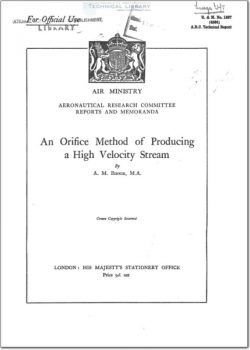ARC-RM-1887

- Version
- 60 Downloads
- 861.19 KB File Size
- 1 File Count
- June 16, 2016 Create Date
- June 16, 2016 Last Updated
An Orifice Method of Producing a High Velocity Stream

Earlier papers (Binnie 1938 and 1940) have dealt with the uniformity of the stream produced
by a venturi flume and with the possibility of employing this device for testing model seaplane
floats. If the velocity of the stream is to be as high as 40 ft. /sec., a net head (i.e., vertical distance
between the supply level and the surface of the channel) of 25 ft. is required. In a venturi
flume with an expansion ratio of 2, and working at this net head, the ratio of downstream to
upstream depth would be at least 0-25. Hence the gross head, or vertical distance between
the supply level and the bottom of the channel, would be 33 ft., and the depth of the issuing
stream would be 8 ft., which is unnecessarily large. It will be appreciated that to attain velocities
of this magnitude a very great expenditure of power is required, and therefore the cross section
of the stream should be as small as possible consistent with the requirements of the experiments.
The expansion ratio might be increased to reduce the depth of the stream and to raise slightly
its velocity, but only at the expense of its uniformity.
It is, however, possible that a satisfactory and more economical stream might be produced
by means of a rectangular orifice inserted in the side of a large tank near the bottom, and dis—
charging direct into an open horizontal channel of the same cross—section (Fig. 1). To avoid
contractions, the orifice must be fitted with a trumpet. If we consider a horizontal stream line
at a depth h below the surface in the channel, the constant in Bernoulli’s equation is (H + h),
where H is the net head and the datum is the stream line itself. The pressure head along the
stream line is h, hence the velocity v is given by v2 = ZgH, and is therefore theoretically uniform
over the cross-section.
The arrangement suffers from an obvious disadvantage. The water forming the free surface
in the channel is previously in contact with the upper portion of the trumpet, where a boundary
layer is formed. But it seems possible that the resulting variation in velocity would disappear
within a short distance from the orifice, or it might prove practicable to suppress the boundary
layer by suction or other devices. On the other hand, the arrangement has the advantage
over the venturi flume of producing a stream, the depth of which is independent of the velocity.
Moreover, it is not essential that the source of supply should possess a free surface.
| File | Action |
|---|---|
| ARC-RM-1887 An Orifice Method of Producing a High Velocity Stream.pdf | Download |
Comment On This Post